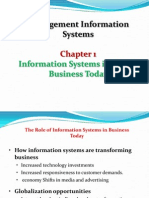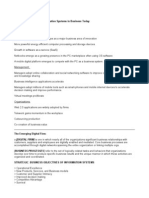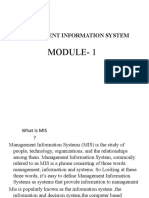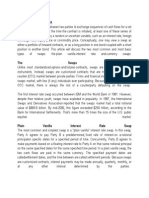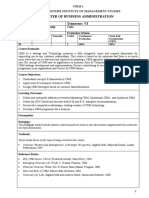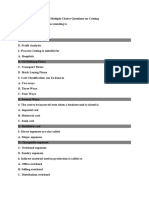LONDON SCHOOL OF COMMERCE
Management Information Systems (Lecture notes 01)
Instructor: Mohammad Moniruzzaman Bhuiya E-mail: shagorx@gmail.com
Management Information Systems (MIS)
CHAPTER 1: INFORMATION SYSTEMS IN GLOBAL BUSINESS TODAY
Explain why information systems are so essential in business today.
Define an information system from both a technical and a business perspective.
Identify and describe the three dimensions of information systems.
Assess the complementary assets required for information technology to provide value to a business.
Identify the major management challenges to building and using information systems.
______________________________________________________________________________________
Explain why information systems are so essential in business today. (OR)
List and describe six reasons why information systems are so important for business today.
Information systems are a foundation for conducting business today. In many industries, survival and even
existence is difficult without extensive use of information technology. Information systems have become
essential for helping organizations operate in a global economy. Organizations are trying to become more
competitive and efficient by transforming themselves into digital firms where nearly all core business
processes and relationships with customers, suppliers, and employees are digitally enabled. Businesses
today use information systems to achieve six major objectives: operational excellence; new products,
services, and business models; customer/supplier intimacy; improved decision making; competitive
advantage; and day-to-day survival.
Business firms invest heavily in information systems to achieve six strategic business objectives
Operational excellence
Improvement of efficiency to attain higher profitability
Information systems, technology an important tool in achieving greater efficiency and productivity
New products, services, and business models
Business model: describes how company produces, delivers, and sells product or service to create
wealth
Information systems and technology are a major enabling tool for new products, services, business
models
Customer and supplier intimacy
Serving customers well leads to customers returning, which raises revenues and profits
E.g. High-end hotels that use computers to track customer preferences (room temperature, TV
channels) and use IS to monitor and customize environment
Intimacy with suppliers allows them to provide vital inputs, which lowers costs
Page 1 of 5
� Improved decision making
Leads to:
Without accurate information managers must use forecasts, best guesses, luck
Overproduction/underproduction of goods and services
Misallocation of resources
Poor response times
Poor outcomes raise costs, lose customers
Competitive advantage
Delivering better performance
Charging less for superior products
Responding to customers and suppliers in real time
Often achieved through one of first four strategic business objectives
E.g. Dell: Consistent profitability over 25 years; Dell remains one of the most efficient producer of
PCs in world (mass customization)
But Dell has lost some of its advantages to fast followers– HP (competitive advantage is not
sustainable)
Survival
Information systems and technologies as a necessity for businesses to survive
Industry-level changes, e.g. the introduction of ATMs by one bank forces other banks to follow
Driven by:
Governmental regulations requiring record-keeping
Toxic Substances Control Act, Sarbanes-Oxley Act (after the Enron scandal, retain audit
Firms need IS capability to respond to these requirements
papers and records including e-mails for 5 years)
Information systems are the foundation for conducting business today. In many industries, survival and even
existence without extensive use of IT is inconceivable, and IT plays a critical role in increasing productivity.
Although information technology has become more of a commodity, when coupled with complementary
changes in organization and management, it can provide the foundation for new products, services, and ways
of conducting business that provide firms with a strategic advantage.
Define an information system from both a technical and a business perspective.
From a technical perspective, an information system collects, stores, and disseminates information from an
organization’s environment and internal operations to support organizational functions and decision
making, communication, coordination, control, analysis, and visualization. Information systems transform
raw data into useful information through three basic activities: input, processing, and output. From a
business perspective, an information system provides a solution to a problem or challenge facing a firm and
provides real economic value to the business.
What Is an Information System?
An information system can be defined technically as a set of interrelated components that collect (or
retrieve), process, store, and distribute information to support decision making and control in an
organization. In addition to supporting decision making, coordination, and control, information systems may
also help managers and workers analyze problems, visualize complex subjects, and create new products.
Page 2 of 5
� Technical perspectives on Information Systems
Set of interrelated components
Collect, process, store, and distribute information
Support decision making, coordination, and control
Input: Captures raw data from organization or external environment
Three activities produce information organizations need
Processing: Converts raw data into meaningful form
Output: Transfers processed information to people or activities that use it
Output returned to appropriate members of organization to help evaluate or correct input stage
Feedback
Data are streams of raw facts
Information vs. data
Information is data shaped into meaningful form
Computers and software are technical foundation and tools, similar to the material and tools used
Computer/Computer program vs. information system
Information systems are more than computers
to build a house
Business perspective on information systems:
Information systems are instruments for creating value
Productivity increases
Investments in information systems and technology will result in superior returns:
Revenue increases
Superior long-term strategic positioning
But not always!!
Investing in information technology does not guarantee good returns (big failures by firms like HP,
Nike, Nestle)
Considerable variation in the returns firms receive from systems investments
Success requires a business perspective: attention to the organizational and managerial nature of
information systems
Adopting the right business model
Success Factors:
Investing in complementary assets (organizational and management capital)
Identify and describe the three dimensions of information systems.
An information system represents a combination of management, organization, and technology elements.
The management dimension of information systems involves leadership, strategy, and management behavior.
The technology dimensions consist of computer hardware, software, data management technology, and
networking/telecommunications technology (including the Internet). The organization dimension of
information systems involves the organization’s hierarchy, functional specialties, business processes,
culture, and political interest groups.
Organizational dimension of information systems
Page 3 of 5
� Hierarchy of authority, responsibility
Senior management
Middle management
Operational management
Knowledge workers
Data workers
Production or service workers
Separation of business functions
Sales and marketing
Human resources
Finance and accounting
Production and manufacturing
Unique business processes
Unique business culture
Organizational politics
Management dimension of information system
Managers set organizational strategy for responding to business challenges
Managers control and coordinate
Creation of new products and services
In addition, managers must act creatively:
Occasionally re-creating the organization
Technological dimension of information systems
Computer hardware and software
Data management technology
Networks, the Internet, intranets and extranets, World Wide Web
Networking and telecommunications technology
IT infrastructure: provides platform that system is built on
Assess the complementary assets required for information technology to provide value to a business.
An information system is part of a series of value-adding activities for acquiring, transforming, and
distributing information to improve management decision making, enhance organizational performance,
and, ultimately, increase firm profitability. Information technology cannot provide this value unless it is
accompanied by supportive changes in organization and management called complementary assets. These
complementary assets include new business models, new business processes, a supportive organizational
culture, incentives for management support and innovation, training, and social assets such as standards,
laws and regulations, and telecommunications infrastructure. Firms that make appropriate investments in
these complementary assets, also known as organizational and management capital, receive superior returns
on their information technology investments.
Complementary assets
Page 4 of 5
�
Assets required to derive value from a primary investment
Firms supporting technology investments with investment in complementary assets receive superior
returns
Value must be added through complementary assets such as new business processes, management
behavior, organizational culture, and training.
E.g.: invest in technology and the people to make it work properly
Complementary assets include
Organizational assets
Supportive culture that values efficiency and effectiveness
Appropriate business model
Efficient business processes
Decentralized authority
Managerial assets
Strong senior management support for technology investment and change
Incentives for management innovation
Teamwork and collaborative work environments
Social assets
The Internet and telecommunications infrastructure
IT-enriched educational programs raising labor force
Identify the major management challenges to building and using information systems.
There are five key management challenges in building and using information systems: (1)
designing systems that are competitive and efficient; (2) understanding the system
requirements of a global business environment; (3) creating an information architecture that
supports the organization's goals; (4) determining the business value of information systems;
and (5) designing systems that people can control, understand, and use in a socially and
ethically responsible manner.
Major management challenges
Design competitive and effective systems: rethinking of business processes, not simple automation
Understand system requirements of global business environment: language, cultural and regulatory
barriers
Create information architecture that supports organization’s goal
Determine the business value of information systems
Design systems people can control, understand and use in a socially, ethically responsible manner.
Page 5 of 5

























